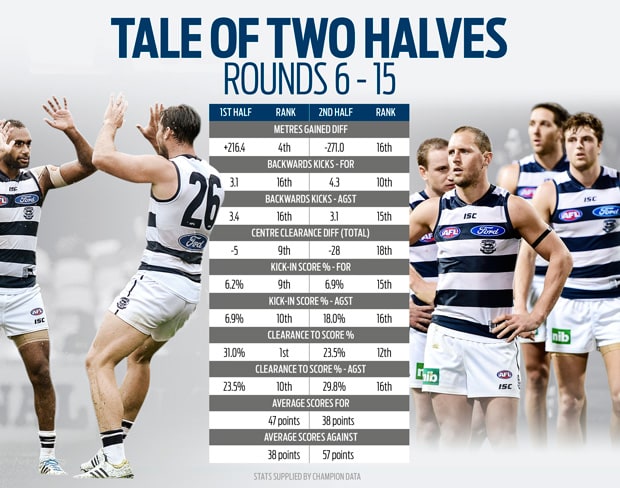But it's lost only once.
That's because despite entering the second-half doldrums in round six, it has won three of its past four last quarters.
Twice in the past month Geelong has overcome three-quarter time deficits to win.
Geelong is gutsy, and it's had a share of luck, but it remains in business.
And, importantly, the Cats also remain a team on the move, effecting a transition under everyone's noses.
Not that you'd know because transition is hardly a sexy topic.
Much better in this age of absolutes to talk about the ending of eras, declining empires, the effects of old age in such a relentless manner that the coach is prompted to use the word epoch in a media conference.
Valid reasons why Geelong has wobbled like a group-one sprinter rounding the turn in the Cox Plate after half-time since round six are clear: Good opposition, interstate travel and a string of six-day breaks.
But none explain what is happening on the ground to the Cats after 'drinks' are taken.
Centre clearances were once again a problem for Geelong in the third quarter on Friday night against Essendon.
Dawson Simpson appeared to be wearing concrete boots – he had copped a knock to the leg – and the midfielders at his feet looked as though they would rather burn out than fade away.
Joel Selwood, Steve Johnson and Josh Caddy's attacking nature left space on the defensive side of the centre circle.
Essendon's Dyson Heppell, Patrick Ryder and David Zaharakis were happy to sprint through those green wedges like surfers negotiating a barrel.
To improve its 18th ranking for centre clearances after half-time since round six (with minus 28 for the period), Geelong needs to set up a defensive sweeper when the opposition gets on top in that area more quickly than a program trader might swoop on the stock market during a volatile period.
Geelong is good enough to do so but it needs to want to make the shift.
Carefully considering how Simpson (64.9 per cent time on ground having been substituted off occasionally), Hamish McIntosh (80.3) and the improving Mark Blicavs (74, occasionally a starting sub) share the workload in the centre square must also be a priority.
Does Blicavs enter the circle more? What's Geelong’s best starting four each situation? These are questions to test the Cats' attacking mindset.
Let's face it. The Cats are prepared to take more risks to see what works than the AFL scheduling department. It's why their leaders are respected.
The Cats are ninth in centre clearances before half-time so it's not an area in which they are dominant anyway, but they need to be better after the long break otherwise its defence cops too much pressure.
Under such pressure, Geelong's defence can sometimes look as vulnerable as an umbrella in high winds.
Geelong has conceded a greater percentage of scores per opposition inside 50 than any other team after half-time since round six.
That's a worry because it's struggling to kick the ball back in effectively. Geelong is the 15th best team at scoring from kick-ins in the second half compared to ninth in the first.
Against Essendon, the Cats often went short to a leading target kicking in. They then tried to create run from the back half. Unfortunately the tactic often broke down in the middle of the ground.
Geelong needs to improve its kick-out system to find an outlet. Harry Taylor – who was off the ground for most of the third quarter against Essendon – will be crucial in supporting a system that works.
It's important Geelong fixes that issue because teams that can break down an opposition's kick-out system gain a psychological edge and appear to tilt the field their way.
Stopping the opposition coming out of defence is also a concern after half-time, with the Cats conceding a score 18 per cent of the time when the opposition kicks out, the worst in the competition and much worse than the manageable 6.9 per cent before half-time.
While most fans like Scott's willingness to let his team attack until the end, there is no shame in protecting percentage given it might become an important determinant of ladder position in 2014.
Geelong's percentage has dropped 42 per cent since round five, a bigger drop than any other team in that time, albeit from a high base.
Since round six, it has been the best performing team in the first half for percentage of scores once inside 50 (a score 50.9 per cent of the time it goes inside 50).
In the second half Geelong drops to 13th scoring at just 46.3 per cent per inside 50.
The Cats aren't worried. They're well and truly in the fight. They are a good team that will only get better.
As for the sideshow speculating on whether this club that has won more games than any other since the competition became the AFL in 1990 can continue to defy gravity and stay near the top, Scott has one message.
"I reckon there are some people lining up to call the end, which is OK. I've been dealing with it for four years."




